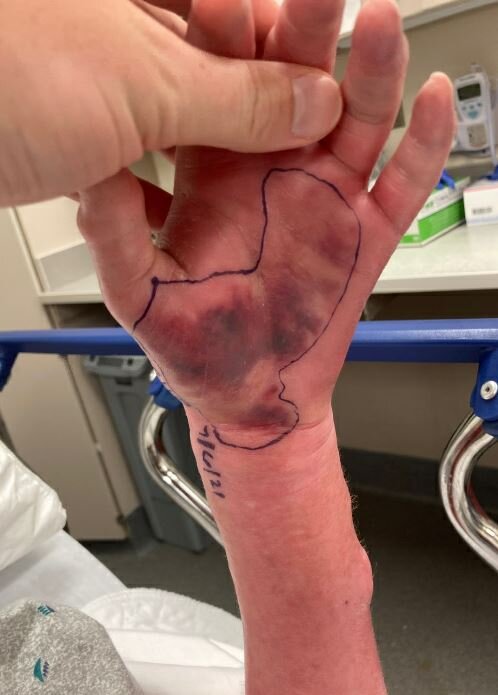A 71 y.o. woman with scleroderma and CREST syndrome comes in with hand pain
she has distal pulses and multiple nodules from her calcinosis
the hand is swollen and the skin is tight
the palm has ecchymosis The patient is in severe pain. . what do you think is wrong?
Our patient had necrotizing fasciitis resulting in necrotic tissue in her hand. It usually begins with red or purple skin, severe pain and fever followed by tissue death. Gas may or may not be found in the tissues. Often bacteria enter through a break in the skin . Patients with poor immune function: diabetics, those who are immune suppressed and those with peripheral artery disease are at risk.
Necrotizing fasciitis occurs in 0.4 people per 100,000 per year in the US. It was described in the time of Hippocrates although the term was first used in 1952.
Four classes of infection have been described.
TYPE I- This is the most common type of infection accounting for 70-80% of cases. The bacteria are mixed with Gram-positive cocci being the most common. Gram negative and anaerobic bacteria are often found in perineal infections (Fournier’s gangrene). Clostridium species are found in 10% . Both clostridial infections and group A strep can rapidly progress to shock. Clostridium toxins cause hemolysis of RBCs and can result in severe anemia.
Fournier’s is usually caused by multiple organisms
TYPE II- This infection accounts for 20-30% of cases and is caused by Strep pyogenes alone or in combination with Strep. Strep species produce M protein which stimulates a massive immune response which is not effective against the bacteria. This massive immune response results in shock. Commonly,this type of infection affects young, healthy adults with a history of injury.
Type III- This infection is caused by vibrio vulnificus which is a bacteria found in salt water. Often this looks like a type II infection but sometimes has little in the way of skin changes and presents as pain.
vibrio vulnificus is found in salt water
Type IV- This infection is fungal in origin.
The treatment of necrotizing fasciitis is surgical debridement and antibiotics . No clear difference has been shown with hyperbaric oxygen or IVIG. While a scoring system has been developed for detecting necrotizing fasciitis it relies on: CRP> 150 , WBC > 15, and Na<135. All of these can be present in any type of inflammation and so are not clinically very useful.
Our patient had debridement and faciotomy 7/6 and grew MSSA. She continued to have pain in her hand thought secondary to Reynaud’s. She returned to the OR 7/15 for a free flap and will be treated with Ancef.
Trivia
In 1994 a cluster of cases was noted in Gloucestershire England. Two cases were traced to surgeries they had had in which they were contaminated by Strep pyogenes.
Don Rickles, a comedian, contracted the disease in his L leg and required six surgeries.
Alex Smith ,an NFL quarterback ,contracted the disease after a compound fracture of his leg.
Timo W, Kopari N, Pham T, Evans H. Necrotizing soft tissue infections:Review and current concepts in treatment, systems of care, and outcomes. Current Problems in Surgery.2014 . 51(8):344-62.
Hua C, Bosc R, Sbidian E, DeProst N, et al. Interventions for necrotizing soft tissue infections in adults. The Cochrane Database of Systematic reviews. 5 CD011680. May 2018 doi:10.1002/14651858 CD011680.pub2 PMC 6494525.
Su, Y, chen H, Hong Y, et al. Laboratory risk indicator for necrotizing fasciitis score and the outsomes. ANZ Jounal of Surgery 78(11)968-72.




